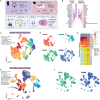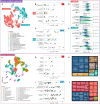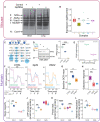Cross-species analysis identifies mitochondrial dysregulation as a functional consequence of the schizophrenia-associated 3q29 deletion
- PMID: 37585521
- PMCID: PMC10431714
- DOI: 10.1126/sciadv.adh0558
Cross-species analysis identifies mitochondrial dysregulation as a functional consequence of the schizophrenia-associated 3q29 deletion
Abstract
The 1.6-megabase deletion at chromosome 3q29 (3q29Del) is the strongest identified genetic risk factor for schizophrenia, but the effects of this variant on neurodevelopment are not well understood. We interrogated the developing neural transcriptome in two experimental model systems with complementary advantages: isogenic human cortical organoids and isocortex from the 3q29Del mouse model. We profiled transcriptomes from isogenic cortical organoids that were aged for 2 and 12 months, as well as perinatal mouse isocortex, all at single-cell resolution. Systematic pathway analysis implicated dysregulation of mitochondrial function and energy metabolism. These molecular signatures were supported by analysis of oxidative phosphorylation protein complex expression in mouse brain and assays of mitochondrial function in engineered cell lines, which revealed a lack of metabolic flexibility and a contribution of the 3q29 gene PAK2. Together, these data indicate that metabolic disruption is associated with 3q29Del and is conserved across species.
Figures





Update of
-
Cross-species transcriptomic analysis identifies mitochondrial dysregulation as a functional consequence of the schizophrenia-associated 3q29 deletion.bioRxiv [Preprint]. 2023 May 26:2023.01.27.525748. doi: 10.1101/2023.01.27.525748. bioRxiv. 2023. Update in: Sci Adv. 2023 Aug 18;9(33):eadh0558. doi: 10.1126/sciadv.adh0558. PMID: 36747819 Free PMC article. Updated. Preprint.
Similar articles
-
Behavioral Phenotypes and Comorbidity in 3q29 Deletion Syndrome: Results from the 3q29 Registry.J Autism Dev Disord. 2025 Feb;55(2):667-677. doi: 10.1007/s10803-023-06218-w. Epub 2024 Jan 12. J Autism Dev Disord. 2025. PMID: 38216835 Free PMC article.
-
Cross-species transcriptomic analysis identifies mitochondrial dysregulation as a functional consequence of the schizophrenia-associated 3q29 deletion.bioRxiv [Preprint]. 2023 May 26:2023.01.27.525748. doi: 10.1101/2023.01.27.525748. bioRxiv. 2023. Update in: Sci Adv. 2023 Aug 18;9(33):eadh0558. doi: 10.1126/sciadv.adh0558. PMID: 36747819 Free PMC article. Updated. Preprint.
-
Convergent and distributed effects of the 3q29 deletion on the human neural transcriptome.Transl Psychiatry. 2021 Jun 15;11(1):357. doi: 10.1038/s41398-021-01435-2. Transl Psychiatry. 2021. PMID: 34131099 Free PMC article.
-
Unraveling the genetic architecture of copy number variants associated with schizophrenia and other neuropsychiatric disorders.J Neurosci Res. 2017 May;95(5):1144-1160. doi: 10.1002/jnr.23970. Epub 2016 Nov 8. J Neurosci Res. 2017. PMID: 27859486 Free PMC article. Review.
-
A clinical case report and literature review of the 3q29 microdeletion syndrome.Clin Dysmorphol. 2015 Jul;24(3):89-94. doi: 10.1097/MCD.0000000000000077. Clin Dysmorphol. 2015. PMID: 25714563 Free PMC article. Review.
Cited by
-
Rare Copy Number Variants Reveal Critical Cell Types and Periods of Brain Development in Neurodevelopmental Disorders.Biol Psychiatry Glob Open Sci. 2025 Apr 1;5(4):100495. doi: 10.1016/j.bpsgos.2025.100495. eCollection 2025 Jul. Biol Psychiatry Glob Open Sci. 2025. PMID: 40469813 Free PMC article.
-
ESC models of autism with copy-number variations reveal cell-type-specific translational vulnerability.Cell Genom. 2025 Jun 11;5(6):100877. doi: 10.1016/j.xgen.2025.100877. Cell Genom. 2025. PMID: 40505628 Free PMC article.
-
Unraveling the enigma of mental disorders: a genetics-first approach and the role of mouse models based on rare disease-susceptible genome variants.Nagoya J Med Sci. 2025 May;87(2):196-210. doi: 10.18999/nagjms.87.2.196. Nagoya J Med Sci. 2025. PMID: 40765798 Free PMC article. Review.
-
Behavioral Phenotypes and Comorbidity in 3q29 Deletion Syndrome: Results from the 3q29 Registry.J Autism Dev Disord. 2025 Feb;55(2):667-677. doi: 10.1007/s10803-023-06218-w. Epub 2024 Jan 12. J Autism Dev Disord. 2025. PMID: 38216835 Free PMC article.
-
An ace in the hole? Opportunities and limits of using mice to understand schizophrenia neurobiology.Mol Psychiatry. 2025 Sep;30(9):4384-4398. doi: 10.1038/s41380-025-03060-7. Epub 2025 May 22. Mol Psychiatry. 2025. PMID: 40405017 Review.
References
-
- J. G. Mulle, M. J. Gambello, R. Sanchez Russo, M. M. Murphy, T. L. Burrell, C. Klaiman, S. White, C. A. Saulnier, E. F. Walker, J. F. Cubells, S. Shultz, L. Li, 3q29 recurrent deletion, in GeneReviews [Internet], M. P. Adam, G. M. Mirzaa, R. A. Pagon, S. E. Wallace, L. J. H. Bean, K. W. Gripp, A. Amemiya, Eds. (University of Washington, 2016).
-
- Marshall C. R., Howrigan D. P., Merico D., Thiruvahindrapuram B., Wu W., Greer D. S., Antaki D., Shetty A., Holmans P. A., Pinto D., Gujral M., Brandler W. M., Malhotra D., Wang Z., Fajarado K. V. F., Maile M. S., Ripke S., Agartz I., Albus M., Alexander M., Amin F., Atkins J., Bacanu S. A., Belliveau R. A. Jr., Bergen S. E., Bertalan M., Bevilacqua E., Bigdeli T. B., Black D. W., Bruggeman R., Buccola N. G., Buckner R. L., Bulik-Sullivan B., Byerley W., Cahn W., Cai G., Cairns M. J., Campion D., Cantor R. M., Carr V. J., Carrera N., Catts S. V., Chambert K. D., Cheng W., Cloninger C. R., Cohen D., Cormican P., Craddock N., Crespo-Facorro B., Crowley J. J., Curtis D., Davidson M., Davis K. L., Degenhardt F., Del Favero J., DeLisi L. E., Dikeos D., Dinan T., Djurovic S., Donohoe G., Drapeau E., Duan J., Dudbridge F., Eichhammer P., Eriksson J., Escott-Price V., Essioux L., Fanous A. H., Farh K. H., Farrell M. S., Frank J., Franke L., Freedman R., Freimer N. B., Friedman J. I., Forstner A. J., Fromer M., Genovese G., Georgieva L., Gershon E. S., Giegling I., Giusti-Rodriguez P., Godard S., Goldstein J. I., Gratten J., de Haan L., Hamshere M. L., Hansen M., Hansen T., Haroutunian V., Hartmann A. M., Henskens F. A., Herms S., Hirschhorn J. N., Hoffmann P., Hofman A., Huang H., Ikeda M., Joa I., Kahler A. K., Kahn R. S., Kalaydjieva L., Karjalainen J., Kavanagh D., Keller M. C., Kelly B. J., Kennedy J. L., Kim Y., Knowles J. A., Konte B., Laurent C., Lee P., Lee S. H., Legge S. E., Lerer B., Levy D. L., Liang K. Y., Lieberman J., Lonnqvist J., Loughland C. M., Magnusson P. K. E., Maher B. S., Maier W., Mallet J., Mattheisen M., Mattingsdal M., McCarley R. W., McDonald C., McIntosh A. M., Meier S., Meijer C. J., Melle I., Mesholam-Gately R. I., Metspalu A., Michie P. T., Milani L., Milanova V., Mokrab Y., Morris D. W., Muller-Myhsok B., Murphy K. C., Murray R. M., Myin-Germeys I., Nenadic I., Nertney D. A., Nestadt G., Nicodemus K. K., Nisenbaum L., Nordin A., O'Callaghan E., O'Dushlaine C., Oh S. Y., Olincy A., Olsen L., O'Neill F. A., Van Os J., Pantelis C., Papadimitriou G. N., Parkhomenko E., Pato M. T., Paunio T.; Psychosis Endophenotypes International Consortium, Perkins D. O., Pers T. H., Pietilainen O., Pimm J., Pocklington A. J., Powell J., Price A., Pulver A. E., Purcell S. M., Quested D., Rasmussen H. B., Reichenberg A., Reimers M. A., Richards A. L., Roffman J. L., Roussos P., Ruderfer D. M., Salomaa V., Sanders A. R., Savitz A., Schall U., Schulze T. G., Schwab S. G., Scolnick E. M., Scott R. J., Seidman L. J., Shi J., Silverman J. M., Smoller J. W., Soderman E., Spencer C. C. A., Stahl E. A., Strengman E., Strohmaier J., Stroup T. S., Suvisaari J., Svrakic D. M., Szatkiewicz J. P., Thirumalai S., Tooney P. A., Veijola J., Visscher P. M., Waddington J., Walsh D., Webb B. T., Weiser M., Wildenauer D. B., Williams N. M., Williams S., Witt S. H., Wolen A. R., Wormley B. K., Wray N. R., Wu J. Q., Zai C. C., Adolfsson R., Andreassen O. A., Blackwood D. H. R., Bramon E., Buxbaum J. D., Cichon S., Collier D. A., Corvin A., Daly M. J., Darvasi A., Domenici E., Esko T., Gejman P. V., Gill M., Gurling H., Hultman C. M., Iwata N., Jablensky A. V., Jonsson E. G., Kendler K. S., Kirov G., Knight J., Levinson D. F., Li Q. S., McCarroll S. A., McQuillin A., Moran J. L., Mowry B. J., Nothen M. M., Ophoff R. A., Owen M. J., Palotie A., Pato C. N., Petryshen T. L., Posthuma D., Rietschel M., Riley B. P., Rujescu D., Sklar P., Clair D. S., Walters J. T. R., Werge T., Sullivan P. F., O'Donovan M. C., Scherer S. W., Neale B. M., Sebat J.; Cnv and Schizophrenia Working Groups of the Psychiatric Genomics Consortium , Contribution of copy number variants to schizophrenia from a genome-wide study of 41,321 subjects. Nat. Genet. 49, 27–35 (2017). - PMC - PubMed
-
- Russo R. S., Gambello M. J., Murphy M. M., Aberizk K., Black E., Burrell T. L., Carlock G., Cubells J. F., Epstein M. T., Espana R., Goines K., Guest R. M., Klaiman C., Koh S., Leslie E. J., Li L., Novacek D. M., Saulnier C. A., Sefik E., Shultz S., Walker E., White S. P.; Emory 3q29 Project, Mulle J. G., Deep phenotyping in 3q29 deletion syndrome: Recommendations for clinical care. Genet. Med. 23, 872–880 (2021). - PMC - PubMed
MeSH terms
Grants and funding
LinkOut - more resources
Full Text Sources
Medical
Miscellaneous

